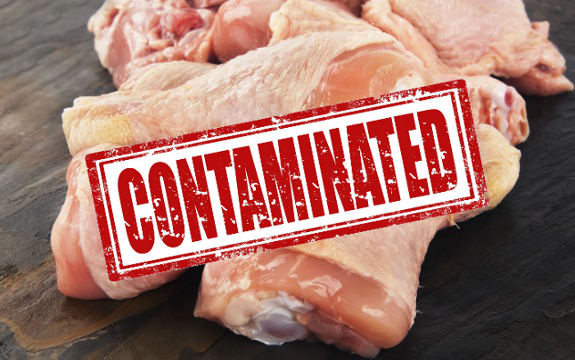Study Finds Conventional Chicken to be Highly Contaminated with Arsenic

 In 2011, a report was issued from the Food and Drug Administration blasting roxarsone, an arsenic-based drug used in chicken production. The FDA announced the Pfizer-made drug was contaminating chicken sold to the American people at a high level. After the scathing report, Pfizer voluntarily pulled roxarsone. But, the arsenic scare isn’t over.
In 2011, a report was issued from the Food and Drug Administration blasting roxarsone, an arsenic-based drug used in chicken production. The FDA announced the Pfizer-made drug was contaminating chicken sold to the American people at a high level. After the scathing report, Pfizer voluntarily pulled roxarsone. But, the arsenic scare isn’t over.
A new study published in Environmental Health Perspectives (EHP) indicates inorganic arsenic (iAs) isn’t only in U.S. chicken, but it’s in most U.S. chicken. While the study focused on chicken treated by roxarsone, another arsenic-creating drug is on the market and being used in chicken production, indicating that the problem is still relevant.
“Arsenical Association: Inorganic Arsenic May Accumulate in the Meat of Treated Chickens” explains that iAs doesn’t pass through chickens without contamination. As a matter of fact, the known-carcinogen accumulates in the muscle tissue, the edible parts of the chicken.
Nitarsone is the name of the drug that essentially replaced roxarsone. It is similar in composition and still contains iAs. For one reason or another, this drug has been allowed to remain in the food system with no real fight from the FDA who had previously blasted roxarsone.
So what is the arsenic used for?
Read: FDA to Finally Remove Arsenic from Animal Feed
Niitarsone is given to chickens to help them grow faster and resist intestinal parasites, something that is difficult to avoid in the cramped and filthy conditions of today’s modern chicken production facilities (which are nothing like the farms of years passed). These drugs also give chicken meat that pink color rather than gray, a color preference that apparently does better on grocery store shelves.
The latest study looked at three different types of chicken: conventional, conventional but antibiotic-free, and certified organic. The researchers found the cooked conventional chicken had the highest level of arsenic, at about 1.8 micrograms per kilogram of body weight (1.8mg/kg). Cooked organic chicken had the lowest levels, at 0.6mg/kg.
The FDA never did officially ban roxarsone nor have they done anything about the newcomer nitarsone (though they are finally making some moves). Because of this, there is a very good chance that all conventionally-produced chicken is being treated with the new and similarly dangerous drug.
“Our study gives the FDA a clear rationale for withdrawing its approval for roxarsone and potentially other arsenic-based drugs in animal agriculture,” said the study’s lead author Keeve Nachman.
Amy Sapkota, assistant professor at the University of Maryland School of Public Health adds, “This study provides the FDA with good data about whether it should formally withdraw the use of arsenicals from chicken production in the U.S.

I have been saying this and saying this, and that “I” NEED TO PULL BACK from Chicken which is known to be a ‘desired staple’ of my ‘feasture’! I KNOW That symptoms of ‘arsenic’ have always plagued me, now that I’m learning what they do! And I’m endeavouring to chelate and detox this out of me, and seeking ways ‘how’ without resorting to medical procedures which I can’t subject myself to, now would I desire to! But I THANK You for this article to ‘validate’!
The wonders of Epsom salt have been well known for hundreds of years and
unlike other salts, Epsom salt has beneficial properties that can
soothe the body, mind and soul. Some of the countless health benefits
include relaxing the nervous system, curing skin problems, soothing back
pain and aching limbs, easing muscle strain, healing cuts, treating
cold and congestion, and drawing toxins from the body. One of the
simplest ways to ease stress and stress-related problems is to soak in a
tub full of hot water with a few cups of epsom salts.
Do a bit of research. And bin the chicken dude.
Of the conventiional, conventional but antiobiotic free, and the cooked certified organic chickens, the cooked certified organic chicken had the least amount of arsenic.
Unless the cooked certified organic chicken was cooked with ingredients containing arsenic, there should be NO arsenic in the certified organic chicken.
Why was there arsenic in the cooked “certified organic” chicken?
I always buy certified organic chicken and I would like to know if this also contains arsenic, because if it does, it shouldn’t be labeled “Certified Organic”.
Micrograms… ug. Milligrams… mg. Otherwise, I think OK. 🙂